
|
Sale 84
January 25-28, 2015 Pre Long Beach
| Lot |
Photo |
Description |
Realized |
Lot 2205 |
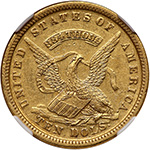 |
1852 $10 U.S. Assay Office 884 THOUS. K-12, High Rarity 7. NGC graded MS-60. O of OFFICE under I of UNITED on tablet on reverse. The obverse has the classic Humbert design for the eagle, while the reverse has the rectangular central portion with the legends surrounded by the engine turned work above and below. Featured here is an evenly toned, khaki-gold survivor that retains sharp striking detail over most of the devices and legends, including all the eagle's feathers. Satiny in texture with original luster discernible over both sides. An overall lack of singularly distracting abrasions is also a pleasing attribute on this conditionally rare Mint State U.S. Assay Office gold coin. Most of those known today show minimal wear and this would make a solid acquisition by an advanced specialist of this series. Pop 6; 46 finer .
Estimated Value $15,000 - 18,000.
View details and enlarged photos
| Unsold |
Lot 2206 |
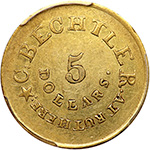 |
Christopher Bechtler, 5 DOLLARS CAROLINA, 134 gr. 21 Carats, With Star. K-20, Rarity 4. PCGS graded AU-53. The Bechtler mint was a private enterprise conducted at the residence of Christopher Bechtler, and operated by his entire family. The enterprise was highly esteemed in its time, well covered in newspapers and financial journals, and served great utility in providing circulating coins of correct gold weight in that region. There were no mints in North Carolina or Georgia until 1838, and the Bechtler enterprise, which began in 1830, served an important early role in monetary affairs.
This Christopher Bechtler gold five exhibits soft olive-gold color with traces of original luster within the legends. A few small field marks are noted, however, none are worthy of individual mention. An important example of a scarce territorial gold variety. Pop 15; 22 finer, 16 in 55, 4 in 58, 2 in 61 (PCGS # 10097) .
Estimated Value $14,000 - 16,000.
View details and enlarged photos
Check results on similar lots
| Unsold |
Lot 2207 |
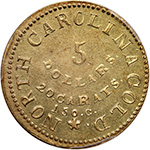 |
Christopher Bechtler, 5 DOLLARS NORTH CAROLINA, 150 Gr. 20 Carats. K-15, Rarity 7. PCGS graded AU-55. One of the second series of Christopher Bechtler five dollar gold coins, K-15 is a highly elusive type in all grades. Indeed, this is the first example that this cataloger can recall handling in a number of years. The obverse die outer legend states C. BECHTLER, ASSAYER with a star below. An inside arc states RUTHERFORD COUNTY in small letters, with a blank center. On the reverse, NORTH CAROLINA GOLD surrounds the border with a star below, at the center is a 5, below in descending arcs are the words DOLLARS / 20 CARATS / 150 G. A beaded border is employed on both dies instead of denticles or the plain raised lip or border used on subsequent Bechtler dies.
Both sides exhibit bold-to-sharp definition from a well-centered and nicely executed strike, not always the case on this rare issue. A lovely partially lustrous example struck in natural green-color gold. The shimmering surfaces are remarkably clean and free from noticeable marks and rim bruises. A Choice AU example of one of the important rarities in the Bechtler series. Pop 7; 2 finer, 1 in 58, 1 in 62 (PCGS # 10118) .
Estimated Value $50,000-UP.
View details and enlarged photos
Check results on similar lots
| Unsold |
Lot 2208 |
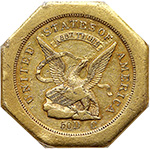 |
1851 Humbert $50 "Slug", 887 THOUS. Lettered Edge, 50 on Reverse. K-4, Rarity 5. PCGS graded AU-55. CAC Approved. The $50 octagonal "slug," was a golden bastion of California commerce during the first years of statehood. Such pieces were used in large transactions, being the coin of choice, since the local residents were repulsed by paper money (paper money was made illegal in the state under the Constitution of 1850.) The octagonal $50 slugs were last made in 1852, after which the Assay Office closed; but the slugs, themselves, continued in use for many years thereafter. Often, they found their way to the various federal mints, where they were melted into bullion, then refashioned into federal denominations. When the Gold Rush began, California was a particularly lawless place. On the day when gold was discovered in 1848 at Sutter's Mill, California was still technically part of Mexico, under American military occupation as the result of the Mexican-American War. With the signing of the treaty ending the war on February 2, 1848, California became a possession of the United States, but it was not a formal "territory" and did not become a state until September 9, 1850.
Generally speaking, all varieties of the U.S. Assay Office fifty dollar octagonal coins are very scarce, however, the Reeded Edge varieties are somewhat more obtainable than their earlier Lettered Edge counterparts. This example, featuring .887 fineness on the ribbon above the eagle, also has lettering around the edges: AUGUSTUS / HUMBERT / UNITED / STATES / ASSAYER / OF GOLD, / CALIFORNIA / 1851. The denomination is seen, both on obverse and reverse, on the latter side as a simple 50 at the center. The surfaces present some deep orange-gold color at the borders, indicative of the copper inherent in the 887-fine gold alloy. While the coin exhibits several corner bumps and rim abrasions, traces of original luster can still be discerned, making for an especially pleasing piece. Pop 5; 9 finer, 3 in 58, 4 in 61, 2 in 62 (PCGS # 10208) .
Estimated Value $120,000-UP.
View details and enlarged photos
Check results on similar lots
| Unsold |
Lot 2209 |
 |
1851 Humbert $50 "Slug", 887 THOUS. Reeded Edge. K-6, Rarity 4. NGC graded AU-55. CAC Approved. The U.S. Assay Office would produce what became the highest denomination U.S. gold coin to circulate -- octagonal-shaped $50 gold coin-ingots, often referred to as "Slugs." On the reverse, the design appears as a series of concentric circles in the center, surrounded by overlapping lines or perhaps a better way of putting it is a series of wavy, concentric circles (found on the reeded edge slugs). These concentric circular lines are known to mechanics as "engine turning," the design is similar to the web-like engraving in the vignettes on paper money or on watchcases, and unique to Territorial Gold struck at the Assay Office of Gold in the early years of the Gold Rush.
This is a visually impressive slug, as are they all, with rich green-gold coloration, and an accumulation of red toning in the recesses of the design, especially on the obverse. The remaining details are about average for the type, the obverse peripheral inscription discernible, although weak in certain areas, and the eagle well detailed over all but the most central features. A few scattered abrasions and a couple of minor rim bruises are noted, but we stress that none of these distractions are overly out-of-context for a lightly circulated gold coin of this size. A historically significant issue that enjoys high collector demand in today's hobby. Pop 12; 28 finer (PCGS # 10214) .
Estimated Value $60,000-UP.
View details and enlarged photos
Check results on similar lots
| Unsold |
Lot 2210 |
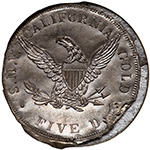 |
1850 $5 Dubosq and Co Die Trail "Splasher" ANACS MS-64. Kagin 3a, Rarity 8. In 1850, Theodore Dubosq and Co. struck five and ten dollar gold coins in San Francisco. Previously, he had been a jeweler in Philadelphia, but decided to move West in 1849 to also profit from the results of the California Gold Rush. According to Breen (1988), only three five dollar gold pieces remain of the approximately 10,000 pieces originally struck, the remainder was apparently melted, a similar fate came to the tens, however, it is now estimated 8 to 10 of that denomination are now known. One of the fives is in the Smithsonian, one is in the Omaha City Library/Byron Reed Collection, and one is a plugged coin that has not been seen since 1951.
This die trial piece, also called a "splasher" is the closest one can come to owning a Dubosq half eagle. Since it is a Territorial Gold pattern, it is also extremely rare in its own right. This is the reverse-only (uniface) splasher struck in white metal. It exhibits a medium gray finish with a somewhat reflective nature. The thin white metal on which this was struck exhibits a concave appearance and it seems to have remnants of paper on the back. Recent research has indicated the engraver of this reverse die might have been James B. Longacre. A number of years ago, patterns were found in his estate and the inventory might have included several Dubosq "splashers." Close inspection shows a remarkable similarity between the eagle on this die trial pattern and federal half eagles of the time. An interesting piece of Western Americana, this die trail is of the greatest importance to collectors of territorial gold.
Estimated Value $12,500-UP.
View details and enlarged photos
| Unsold |
Lot 2211 |
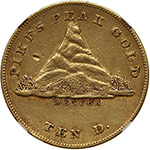 |
1860 $10 Clark-Gruber. K-3, Rarity 5. NGC graded EF-45. Clark, Gruber and Company is the most famous Colorado private gold minter. The Pike's Peak gold rush began in 1859 but word of the discovery began to spread East, West, South and North in the Fall of 1858. To further spark the public's interest, unbelievable fabrications began to appear in print, as though the mere reporting would establish the facts. On September 18, 1858, the Wyandotte Gazette published a "reliable" account concerning $10,000 in gold dust which had come in from Pike's Peak: "One man brought in $600.00 as the result of a few weeks work. A small boy had $1,000, which he says 'he dug down and found,' and the little fellow says 'he can get all he wants." This undocumented account was reprinted in the Missouri Democrat on September 24, and followed the next day by the report of a merchant from St. Joseph, who had come to St. Louis to buy a supply of bacon for the Pike's Peak trade. This and thousands of other newspaper accounts acted like a magnet to draw hopeful gold seekers to the region from which this $10 gold coin is an all-too-solid reminder of those half-forgotten days.
The obverse of this famous gold coin shows an unrealistic image of Pikes Peak, resembling a volcano or a large anthill, which was created by a die sinker in the East who had never been to Colorado or seen this beautiful mountain first recorded by Zebulon Pike on his journey of discovery in 1806. Boldly struck in subtle green-gold with some rose-red highlights, especially within the reverse design. A mark is noted in the left obverse field and a milling mark is noted in the right reverse field, these being mentioned for future identification purposes. Probably the most popular Pioneer gold coin in the entire series, and always in great demand. Pop 2; 52 finer .
Estimated Value $20,000 - 24,000.
View details and enlarged photos
| Unsold |
Lot 2212 |
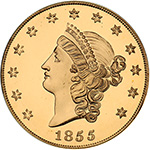 |
1885 (2001) Kellogg $50 S. S. Central America Commemorative Restrike. PCGS graded Gem Proof. Near perfect surfaces and bright golden color. A total of 2½ ounces of gold. Housed in a PCGS special holder.
Estimated Value $3,200 - 3,400.
View details and enlarged photos
| Unsold |
|
|